Yucca plants are some of the most useful plants that are hidden in a multitude of products. Sometimes you can find yucca in hair products, and sometimes even Fido gets some yucca to keep their stank down.
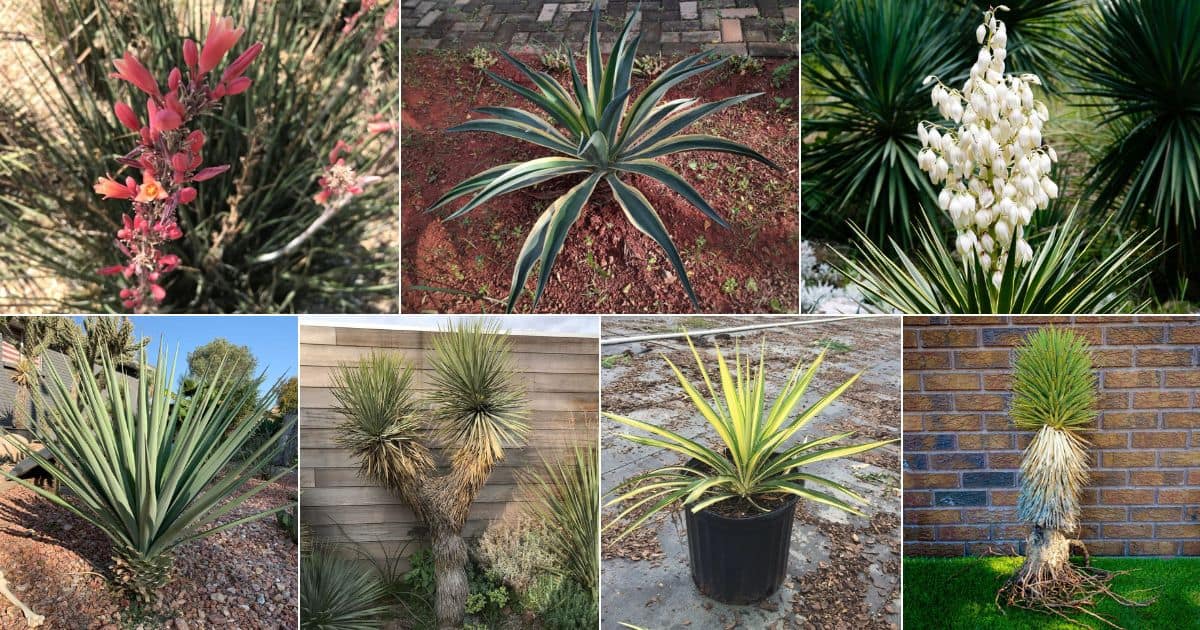
Historically, most parts of yucca plants have been used medicinally, the flowers as snacks and the fruits as full meals. The sap from the leaves has also been used as poison while hunting local prey.
Be careful with yucca, as you should be with any succulent. They are often toothed, spiny, and unyielding. When taken care of correctly, these plants can last generations!
Jump to:
- 1. Yucca Filamentosa
- 2. Adam’s Needle ‘Color Guard’
- 3. Yucca filamentosa ‘Excalibur’
- 4. Yucca Elephantipes
- 5. Spanish Bayonet
- 6. Yucca flaccida
- 7. Yucca gloriosa ‘Bright Star’
- 8. Hesperaloe parviflora
- 9. Joshua Tree
- 10. Yucca glauca
- 11. Yucca baccata
- 12. Mojave Yucca Plant
- 13. Beaked Yucca Plant
- 14. Yucca constricta
- 15. Yucca rupicola
- 16. Yucca whipplei
- 17. Yucca elata
- 18. Yucca pallida
- 19. Yucca faxoniana
- 20. Mountain yucca
- 21. Yucca thompsoniana
- 22. Yucca linearifolia
- 23. Dasylirion wheeleri
1. Yucca Filamentosa
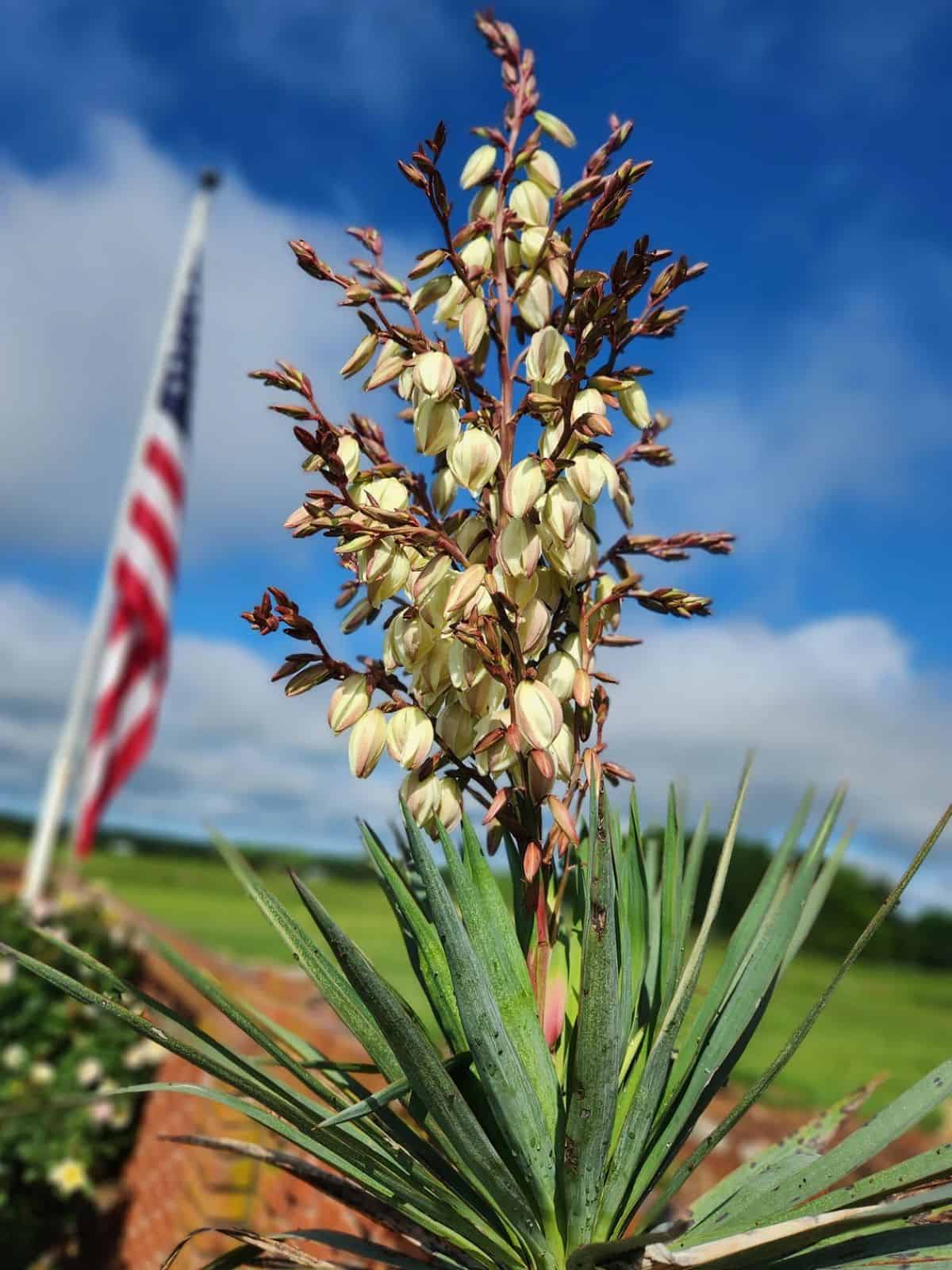
Buy it from:
| Maximum Height: | 3 feet |
| Maximum Width: | 3 feet |
| Watering Needs: | Periodically: can be watered once a month unless showing signs of stress |
| Soil Needs: | Loamy, well-fertilized, and well-drained soil |
| Light Needs: | Full Sun |
| Hardiness Zone(s): | Four and up |
| Bloom Color: | White |
| Bloom Stalk Height: | Up to eight feet |
| Leaf Type: | Thinner sword-like leaves that grow vertically |
| Growth Type: | Produces rooted offshoots easily |
Also known as the original Adam’s Needle or a form of Thread Yucca Plant, this hardy species is the quintessential yucca that you can find just about anywhere. They are extremely hardy, and the simple light-green leaves are a great accent to any garden.
2. Adam’s Needle ‘Color Guard’
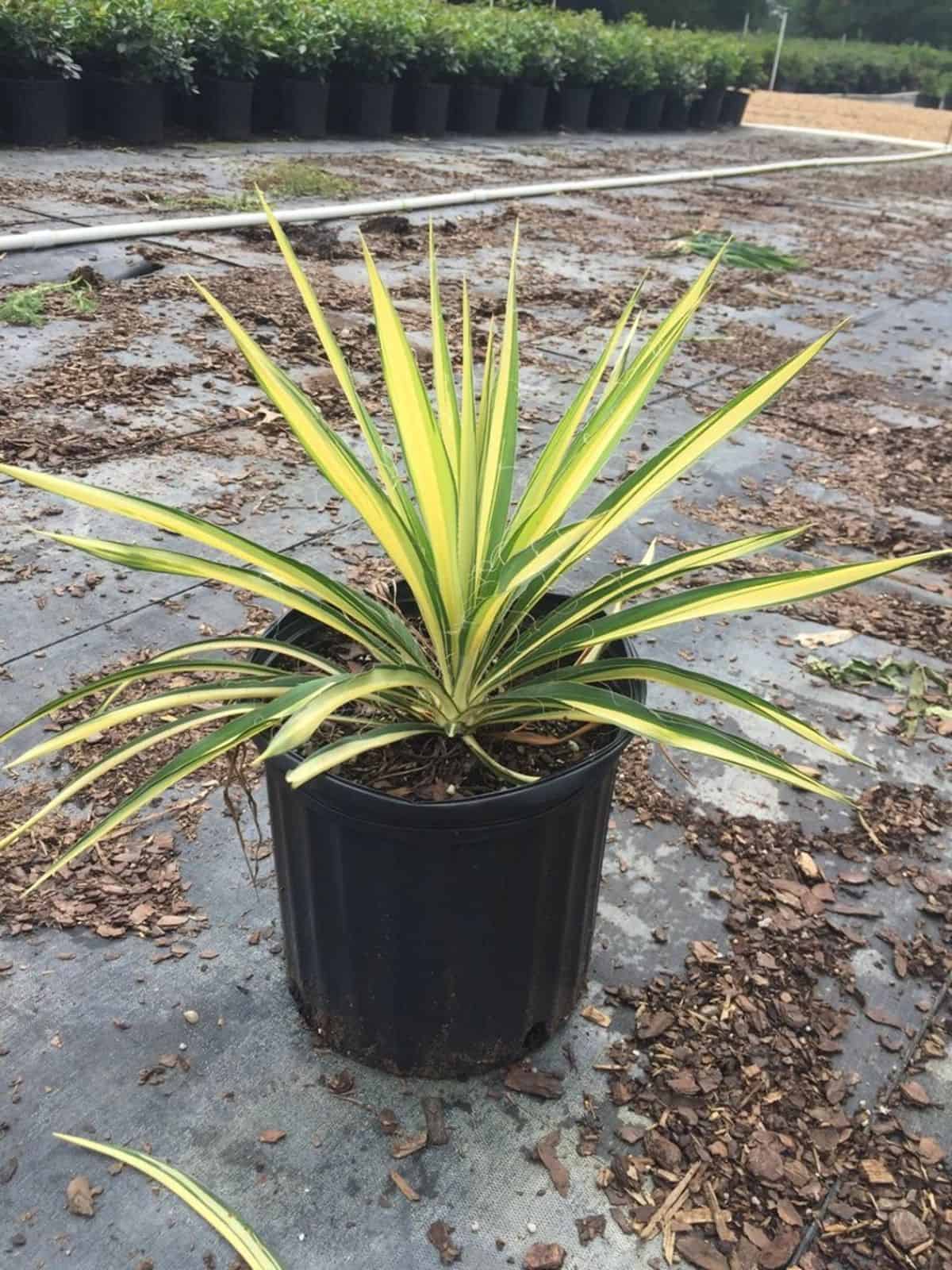
Buy it from:
| Maximum Height: | 3 feet |
| Maximum Width: | 3 feet |
| Watering Needs: | Periodically: can be watered once a month unless showing signs of stress |
| Soil Needs: | Loamy, well-fertilized, and well-drained soil |
| Light Needs: | Full Sun |
| Hardiness Zone(s): | Between zones four and ten |
| Bloom Color: | White to cream |
| Bloom Stalk Height: | 6 feet |
| Leaf Type: | Thinner at the base and the tip, which gives it a more lance-like shape |
| Growth Type: | Easily clusters |
The second of the three variants of Yucca filamentosa is Color Guard. Out of the three, this is by far the most colorful, with yellow and green variegated leaves. Like all yucca, they are equally pointy but are more visually stunning. In some cases, you can find leaves that are predominantly yellow!
3. Yucca filamentosa ‘Excalibur’
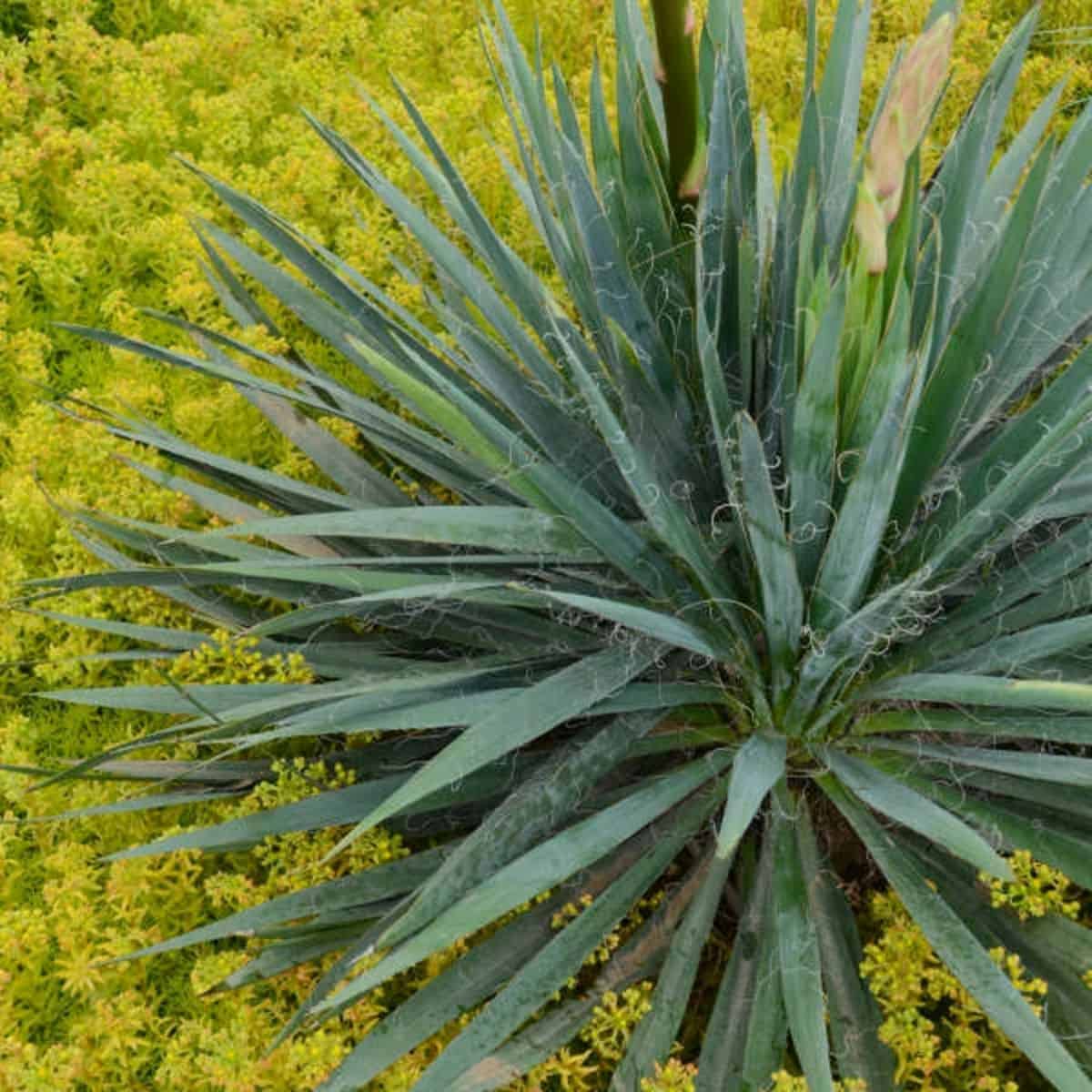
Buy it from:
| Maximum Height: | 2 feet |
| Maximum Width: | 4 feet |
| Watering Needs: | Periodically: can be watered once a month unless showing signs of stress |
| Soil Needs: | Loamy, well-fertilized, and well-drained soil |
| Light Needs: | Full Sun |
| Hardiness Zone(s): | Five to ten |
| Bloom Color: | Creamy white |
| Bloom Stalk Height: | Up to five feet |
| Leaf Type: | Narrow and sword-like with curly filaments |
| Growth Type: | Compact but will easily take over an area |
Out of the three Y. filamentosa’s seen here, this one makes the most sense! Why? Because it actually has filaments that grow along the sides of the leaves. The dark gray-green leaves tend to be thinner than the other Y. filamentosa species and can sometimes exhibit a few darker spots here and there.
4. Yucca Elephantipes
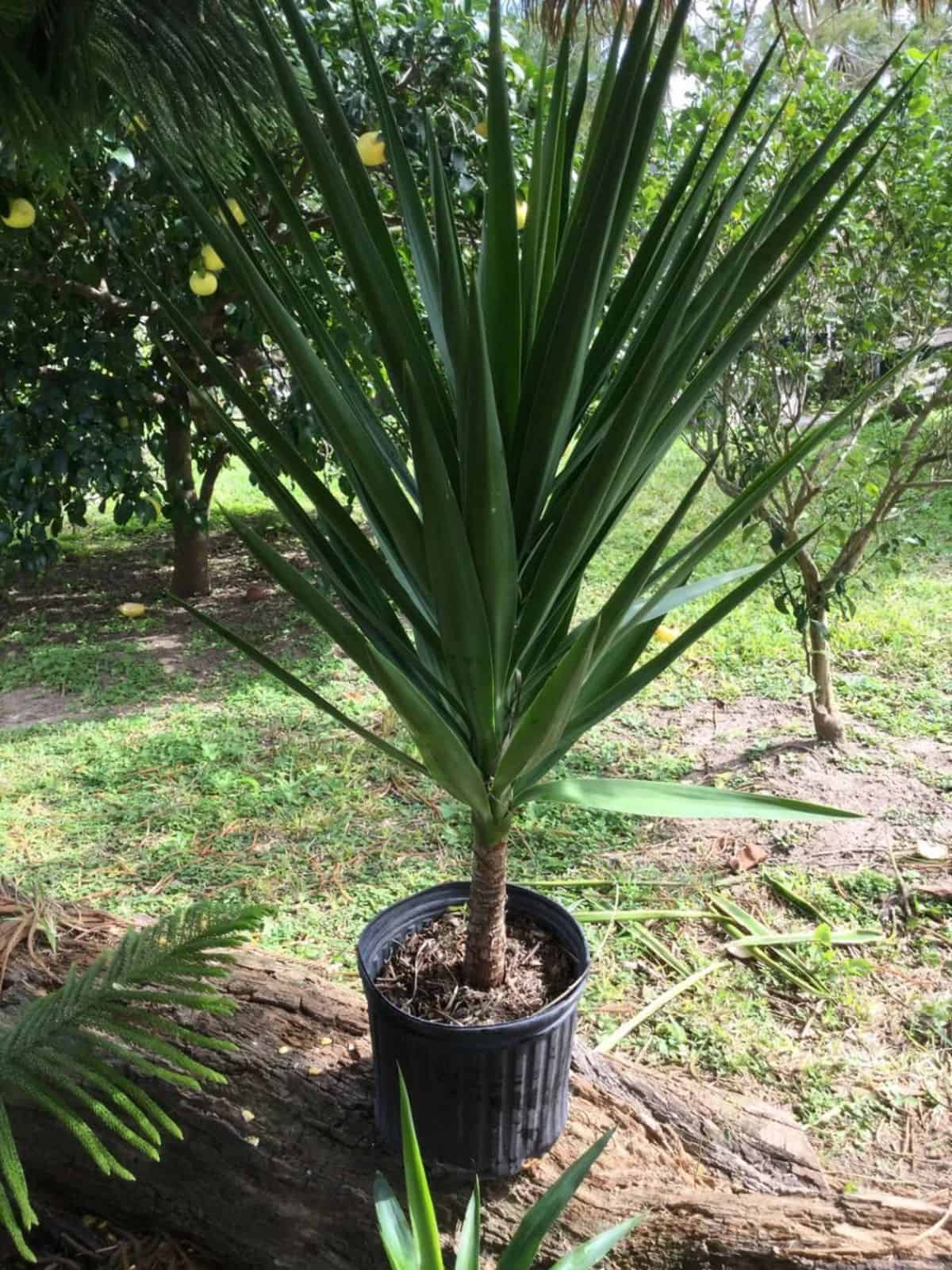
Buy it from:
| Maximum Height: | Up to 30 feet |
| Maximum Width: | Up to 25 feet |
| Watering Needs: | Periodically: can be watered once a month unless showing signs of stress |
| Soil Needs: | Loamy, well-fertilized, and well-drained soil |
| Light Needs: | Full Sun |
| Hardiness Zone(s): | Zone 9 and up |
| Bloom Color: | Creamy-white |
| Bloom Stalk Height: | 3 feet |
| Leaf Type: | Leathery and thick; can get up to four feet in length |
| Growth Type: | Tree |
The spineless yucca plant is the tallest yucca to date. It is grown to provide shade and textural height to gardens. The flowers are full of calcium and potassium and are often used in salads. Spineless yuccas that are planted in the ground will provide more flowers than those that are grown in pots.
5. Spanish Bayonet
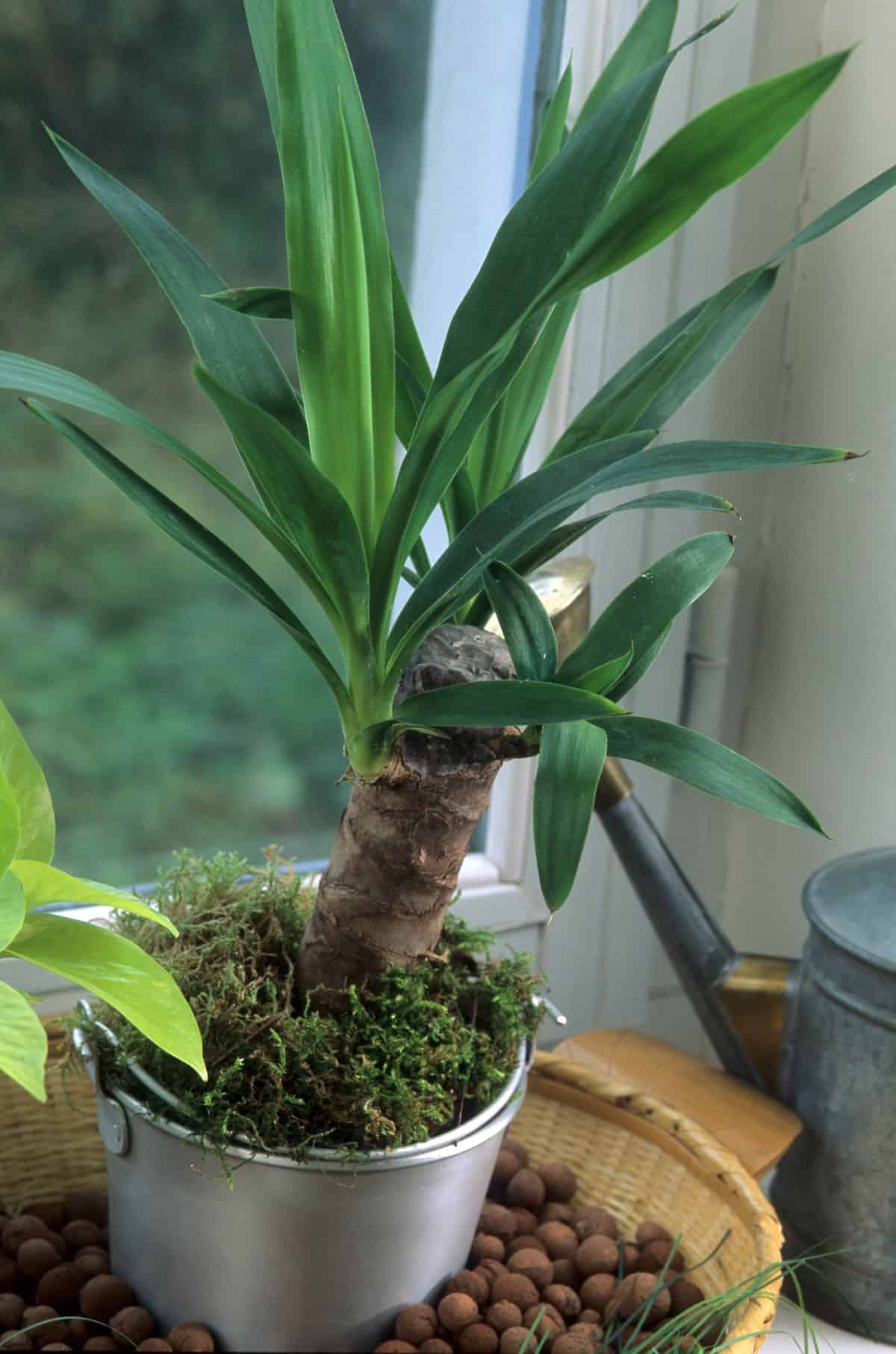
Buy it from:
| Maximum Height: | Up to 10 feet |
| Maximum Width: | Up to 5 feet |
| Watering Needs: | Periodically: can be watered once a month unless showing signs of stress |
| Soil Needs: | Loamy, well-fertilized, and well-drained soil |
| Light Needs: | Full Sun |
| Hardiness Zone(s): | Zone 7 and up |
| Bloom Color: | Creamy white with a slight purple tinge |
| Bloom Stalk Height: | 2 feet |
| Leaf Type: | Shaped like a dagger with very sharp serrations and tips. |
| Growth Type: | Heavily branched with terminal rosettes |
The Spanish Bayonet, specifically Yucca aloifolia (there is another species also known as Spanish Bayonet), is another tree-like type of yucca with impressive stalks and massive leaves. The flowering bodies are generally short at about two feet in height. With contrasting purplish hues, the Spanish bayonet is a regal yucca to include in any garden.
6. Yucca flaccida
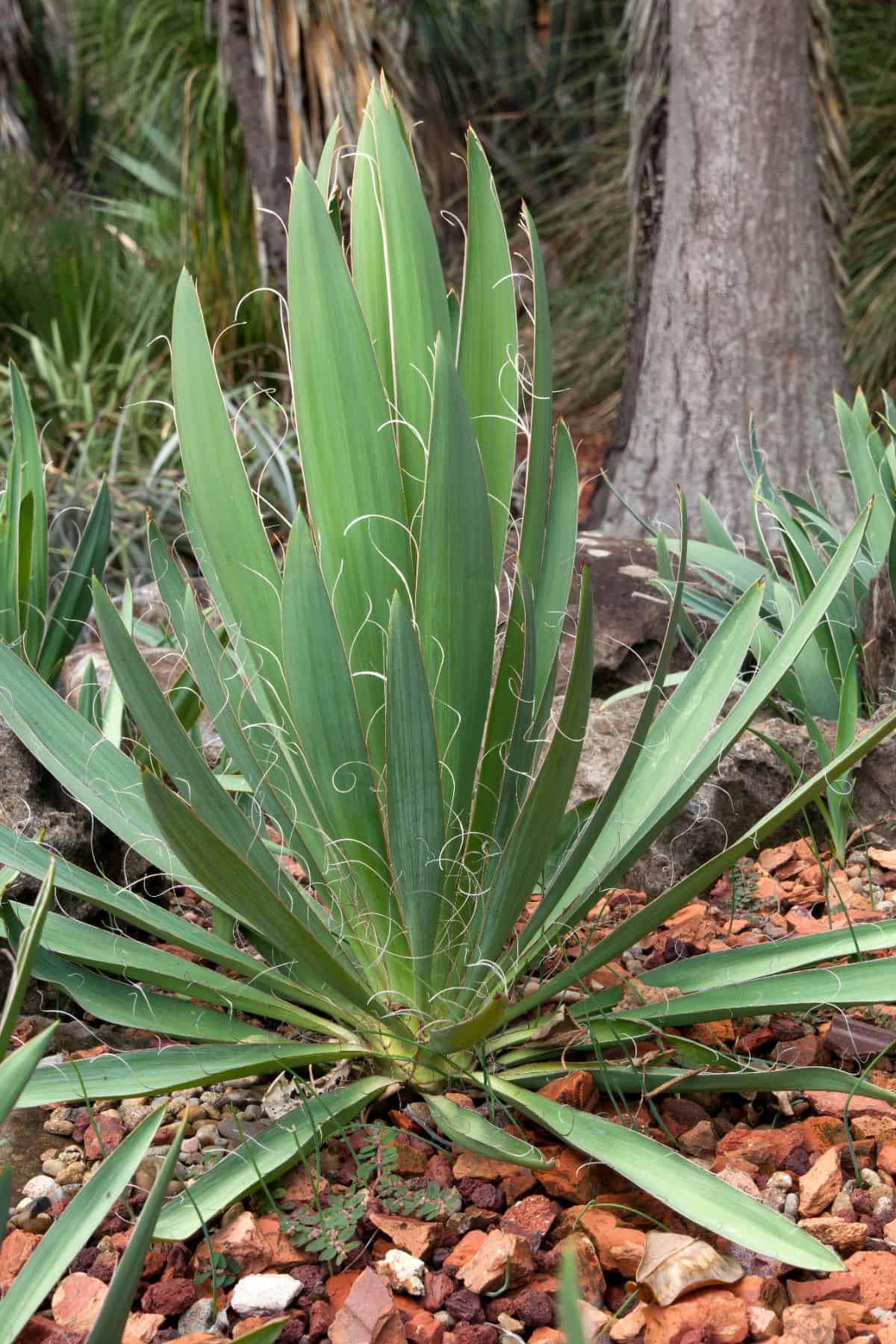
| Maximum Height: | Up to 2 feet |
| Maximum Width: | Up to 2 feet |
| Watering Needs: | Periodically: can be watered once a month unless showing signs of stress |
| Soil Needs: | Loamy, well-fertilized, and well-drained soil |
| Light Needs: | Full Sun |
| Hardiness Zone(s): | Zone 4 and up |
| Bloom Color: | White |
| Bloom Stalk Height: | 2-8 feet |
| Leaf Type: | Sword-like leaves |
| Growth Type: | Evergreen shrub |
Weak-Leaf Yucca Plant or floppy yucca is a stemless species with, as the name suggests, rather floppy leaves. Rather than the mostly vertical types of species that are seen in this post, this one spreads out wide, with the weaker leaves often folding back on themselves as they get longer. A small piece of trivia is that this species is often confused with Y. filamentosa thanks to the filaments that also grow along the edges of the leaves.
7. Yucca gloriosa ‘Bright Star’
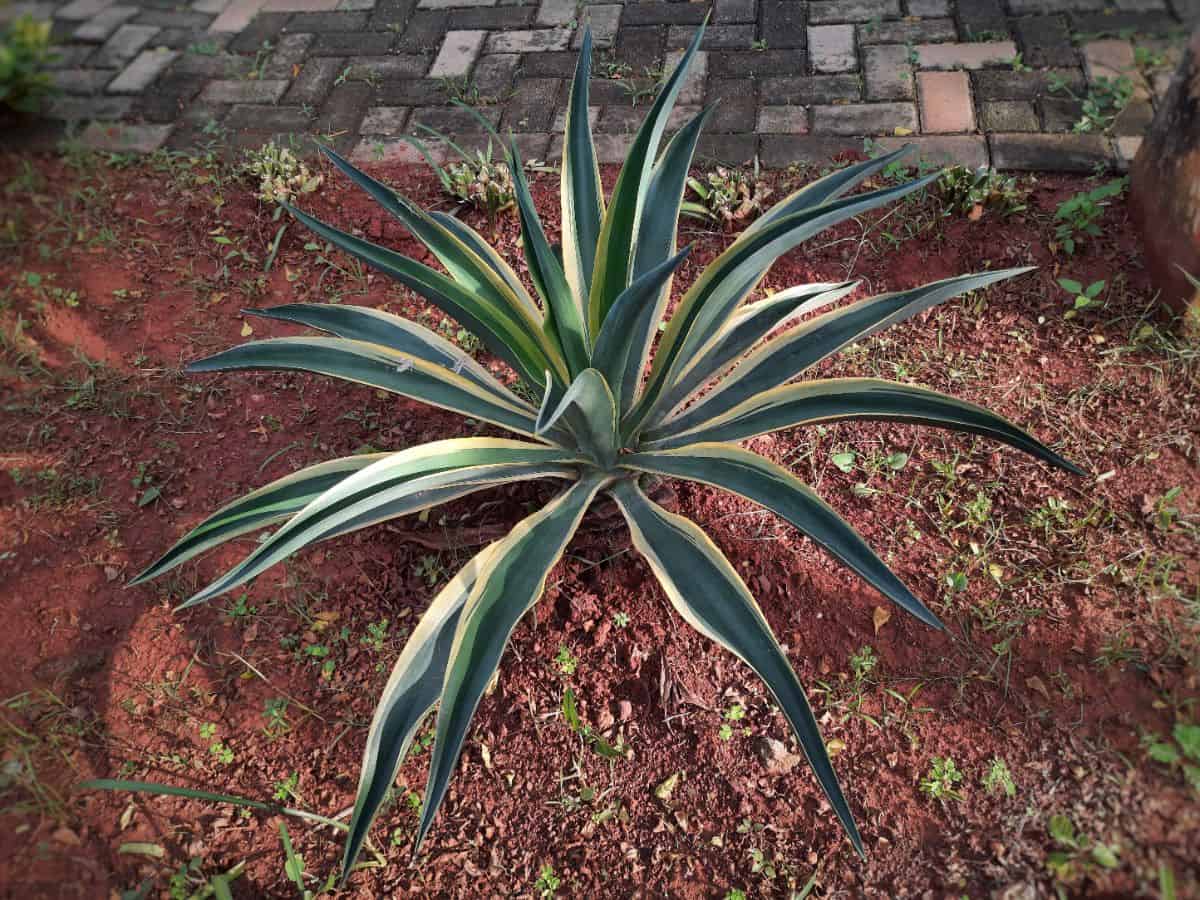
Buy it from:
| Maximum Height: | Up to 4 feet |
| Maximum Width: | Up to 4 feet |
| Watering Needs: | Periodically: can be watered once a month unless showing signs of stress |
| Soil Needs: | Loamy, well-fertilized, and well-drained soil |
| Light Needs: | Full Sun |
| Hardiness Zone(s): | Seven and up |
| Bloom Color: | Creamy white |
| Bloom Stalk Height: | 4 feet |
| Leaf Type: | Dagger-shaped with sharp terminal spines |
| Growth Type: | Ornamental, slow-growing evergreen shrub |
There are several different names for this species: the Spanish Dagger (often confused with bayonet), Variegated Spanish Dagger, and Aureovariegata. What sets this species apart is the deep green to gray-green leaves with striking whitish-yellow edges. The four-foot blooming stalks reach just above the leaves and are often packed full of delicate bell-like flowers.
8. Hesperaloe parviflora
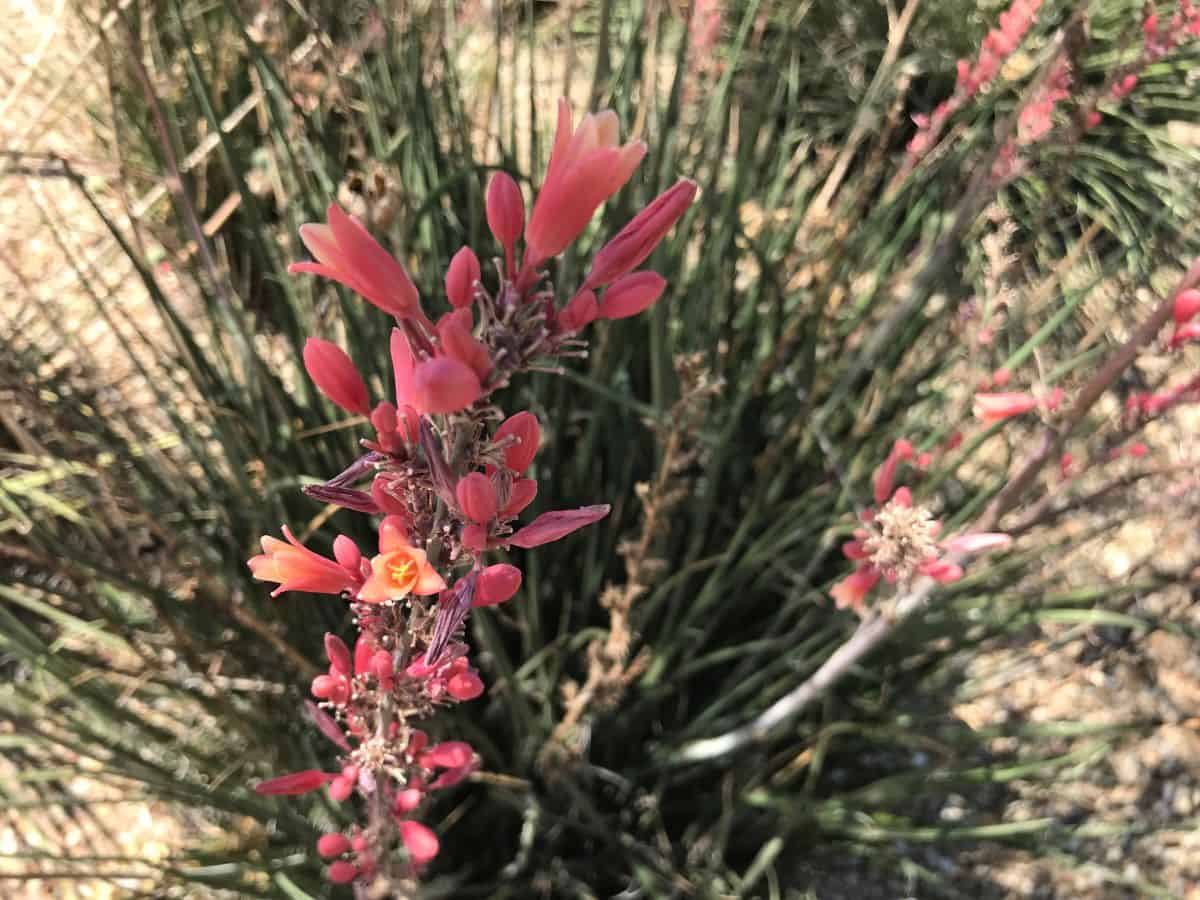
Buy it from:
| Maximum Height: | Up to 5 feet |
| Maximum Width: | Up to 6 feet |
| Watering Needs: | Periodically: can be watered once a month unless showing signs of stress |
| Soil Needs: | Loamy, well-fertilized, and well-drained soil |
| Light Needs: | Full Sun |
| Hardiness Zone(s): | Zone 6 and up |
| Bloom Color: | Reddish pink |
| Bloom Stalk Height: | Up to five feet |
| Leaf Type: | Very thin linear leaves with filaments |
| Growth Type: | Will easily take over through self-seeding |
The Red Yucca plant is one that you will see VERY often in many different landscaping arrangements. Because of the easily manageable size and diminutive flower stalks with ravishing colors, it is easy to care for and often packed together to make red carpets of flowers. There is also a yellow variant of this species; however, the yellow variant is far more difficult to find.
9. Joshua Tree
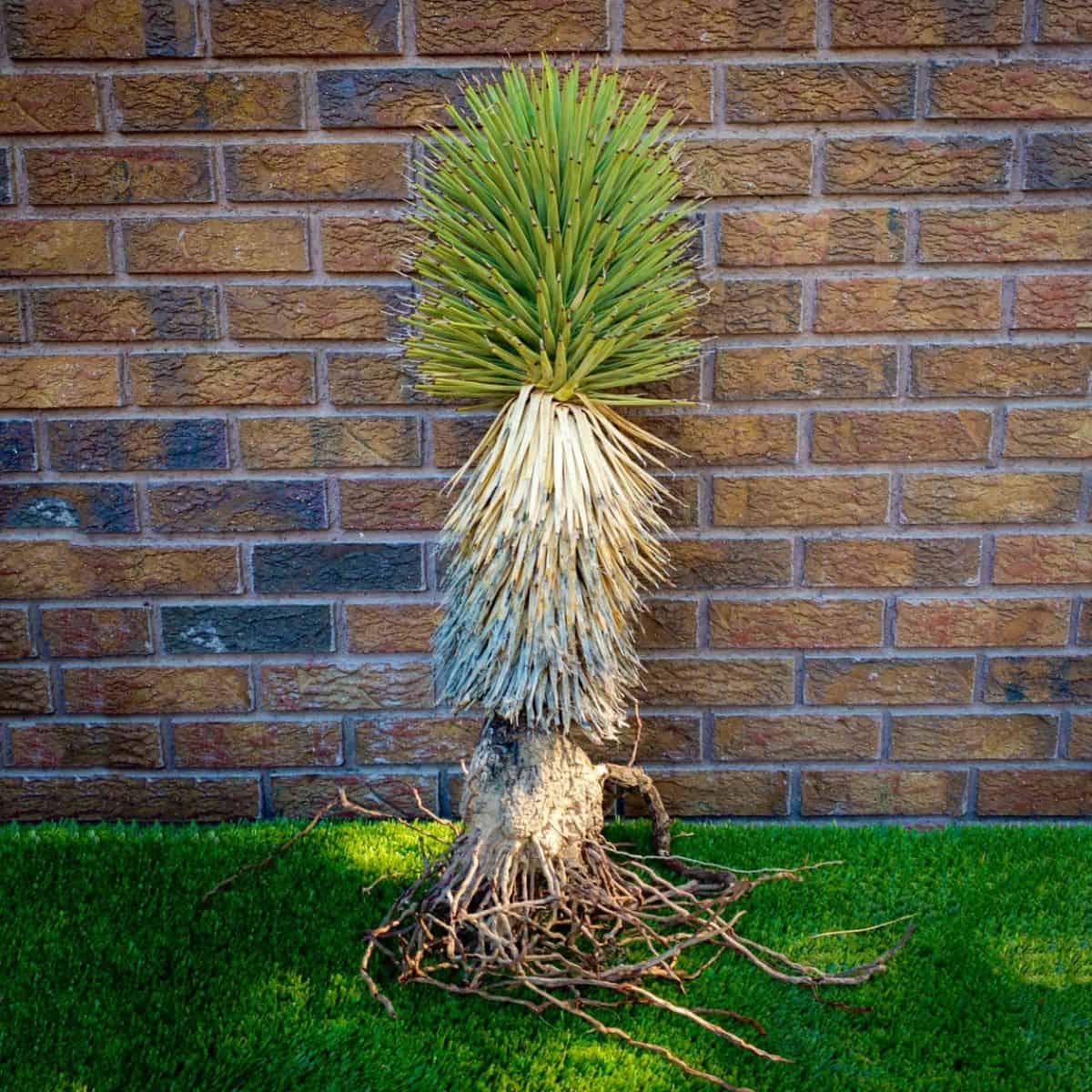
Buy it from:
| Maximum Height: | Up to 30 ft |
| Maximum Width: | Up to 30 ft |
| Watering Needs: | Periodically: can be watered once a month unless showing signs of stress |
| Soil Needs: | Loamy, well-fertilized, and well-drained soil |
| Light Needs: | Full Sun |
| Hardiness Zone(s): | Zones 6 - 10 |
| Bloom Color: | Light white-green |
| Bloom Stalk Height: | Twenty inches |
| Leaf Type: | Very narrow and up to 14 inches long |
| Growth Type: | Tree-like |
One of the more interesting gumtree varieties available is the Joshua Tree. A staple of the Mojave desert, Yucca brevifola is a crowd favorite thanks to its drought tolerance and the fact that it comes in blue and dwarf varieties! There are other stemmed yuccas whose leaves remain on the stem, but the Joshua Tree is unique for its fluffy, almost cuddly-looking stems.
10. Yucca glauca
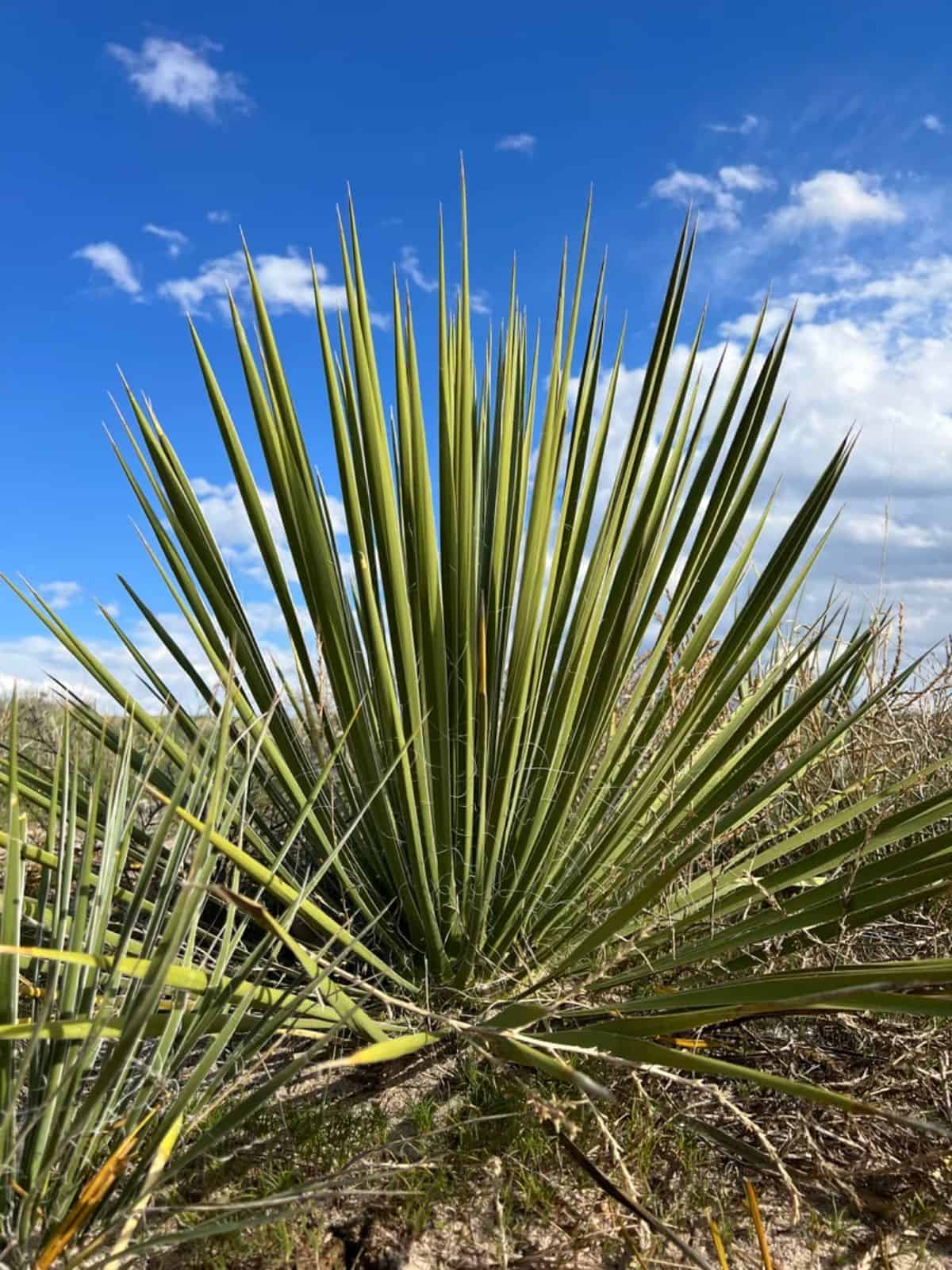
Buy it from:
| Maximum Height: | Up to 4 feet |
| Maximum Width: | Up to 4 feet |
| Watering Needs: | Periodically: can be watered once a month unless showing signs of stress |
| Soil Needs: | Loamy, well-fertilized, and well-drained soil |
| Light Needs: | Full Sun |
| Hardiness Zone(s): | Zone 6 and up |
| Bloom Color: | Creamy green with pink edges |
| Bloom Stalk Height: | 4 feet |
| Leaf Type: | Narrow and strongly built. Tends to stay straight from the base of the plant |
| Growth Type: | Shrub with offshoots and seedlings |
Remember when I mentioned that there is another type of Spanish bayonet that often gets confused with the traditional Y. aloifolia? This is the yucca that shares a similar common name. However, it is also known as Soapweed Yucca Plant. Different parts of the plant are used for upset stomachs, rashes, and even dandruff.
11. Yucca baccata
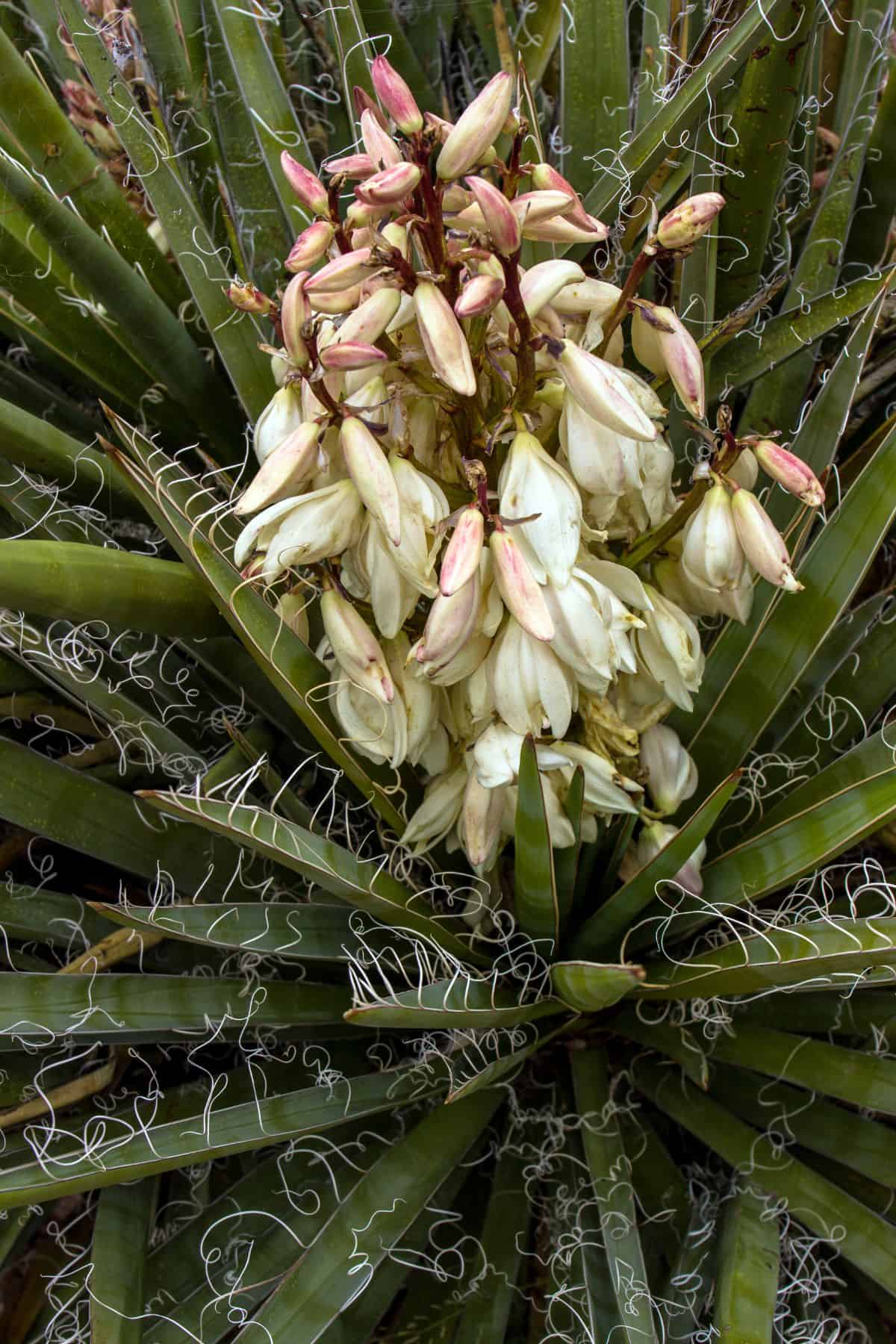
Buy it from:
| Maximum Height: | Up to 5 feet |
| Maximum Width: | Up to 5 feet |
| Watering Needs: | Periodically: can be watered once a month unless showing signs of stress |
| Soil Needs: | Loamy, well-fertilized, and well-drained soil |
| Light Needs: | Full Sun |
| Hardiness Zone(s): | Zone 7 and up |
| Bloom Color: | Yellow-white |
| Bloom Stalk Height: | No stalk; grows from the center of the yucca. |
| Leaf Type: | Broad, leathery, and very stiff |
| Growth Type: | Spiraled rosette with minimal stem |
Also known as the Banana Yucca Plant or broadleaf yucca, this species has a history of covering multiple needs for the indigenous peoples from this plant’s native habitat. The beautiful blooms turn into banana-shaped fruits that, when cooked, provide a nutritious potato-tasting meal. With thick leaves and curly filaments, it’s pretty easy to tell this species apart from others!
12. Mojave Yucca Plant
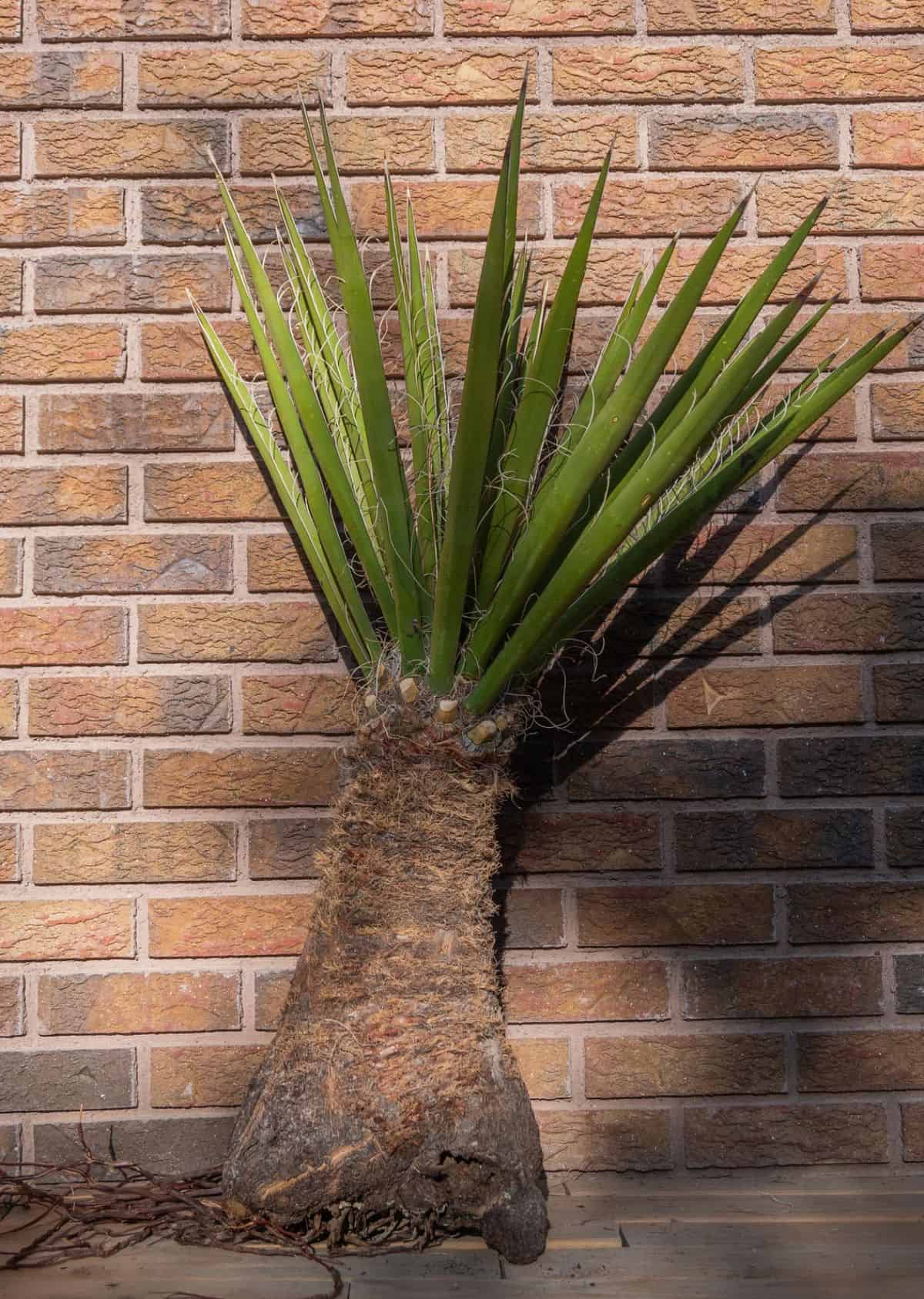
Buy it from:
| Maximum Height: | Up to 16 feet |
| Maximum Width: | Up to 5 feet |
| Watering Needs: | Periodically: can be watered once a month unless showing signs of stress |
| Soil Needs: | Loamy, well-fertilized, and well-drained soil |
| Light Needs: | Full Sun |
| Hardiness Zone(s): | Zone 7 and up |
| Bloom Color: | Greenish white |
| Bloom Stalk Height: | 2 - 4 feet |
| Leaf Type: | Leathery and long with white filaments. Leaves are generally 1 - 4 feet in length and four inches across |
| Growth Type: | Considered to be tree-like |
Yucca schidigera, or another type of Spanish dagger, is a tree-like yucca that often grows in patches and is closely related to Y. baccata. More often than not, crosses between the two are found in their natural habitat. Like Y. baccata, there are several medicinal uses for the roots, and the flowers can also be a nutritious addition to meals.
The leaves reach upward and outward on feathered and scaly stems, which is what gives them their length and width.
13. Beaked Yucca Plant
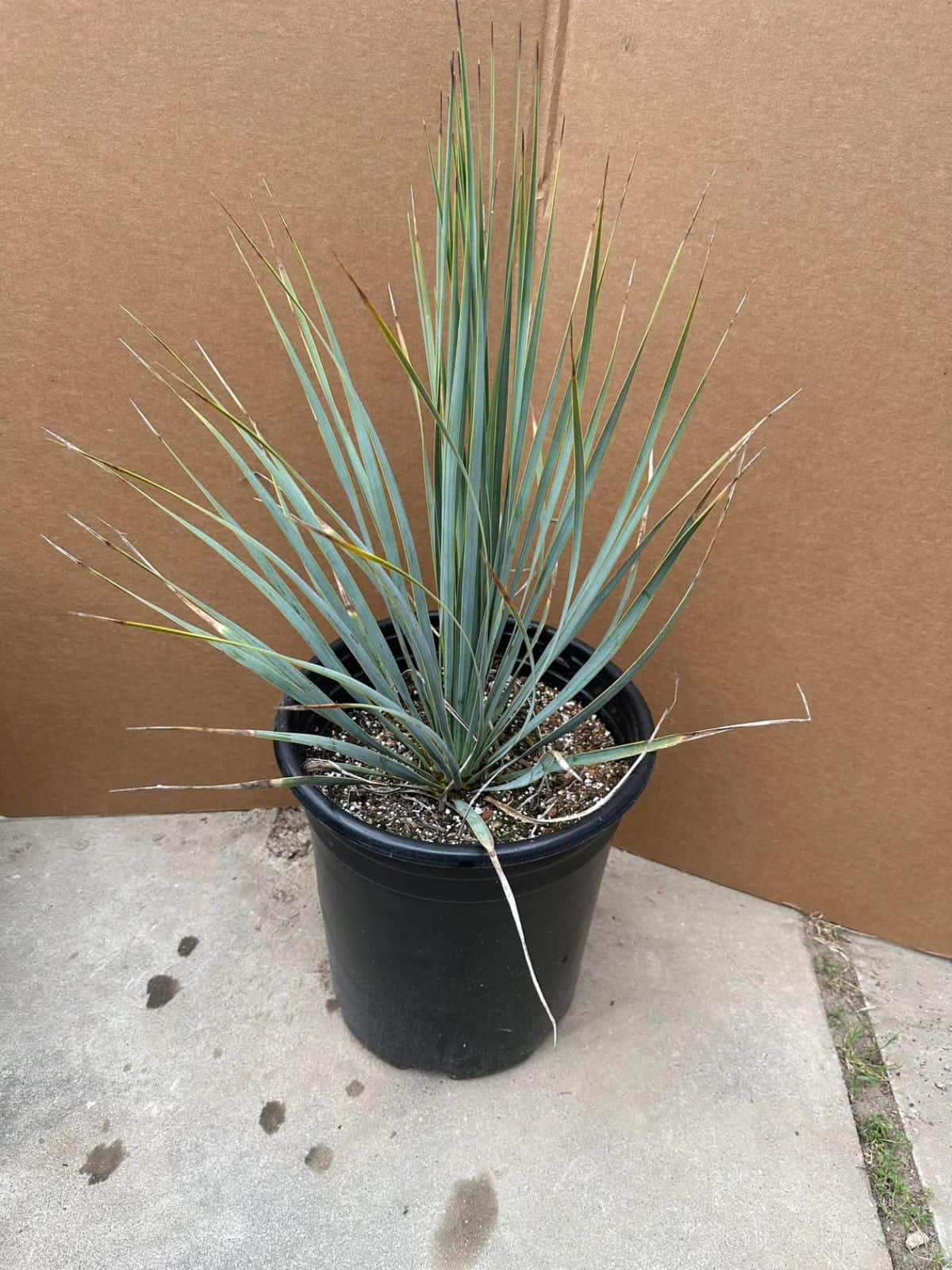
Buy it from:
| Maximum Height: | Up to 15 feet |
| Maximum Width: | Up to 10 feet |
| Watering Needs: | Periodically: can be watered once a month unless showing signs of stress |
| Soil Needs: | Loamy, well-fertilized, and well-drained soil |
| Light Needs: | Full Sun |
| Hardiness Zone(s): | Zone 5 and up |
| Bloom Color: | Creamy white |
| Bloom Stalk Height: | Bright orange/yellow and only on mature plants |
| Leaf Type: | Tender, blue-grey leaves that remain on the plant |
| Growth Type: | Tree type of yucca |
Yucca rostrata is considered to be one of the more ornamental types of yucca out there. With their thin and plentiful gray-blue leaves, they take up a prominent space in any garden. As the leaves die back, they begin to form hairy-looking protection around the stem or trunk. This is what helps them survive some of the harder winters.
14. Yucca constricta
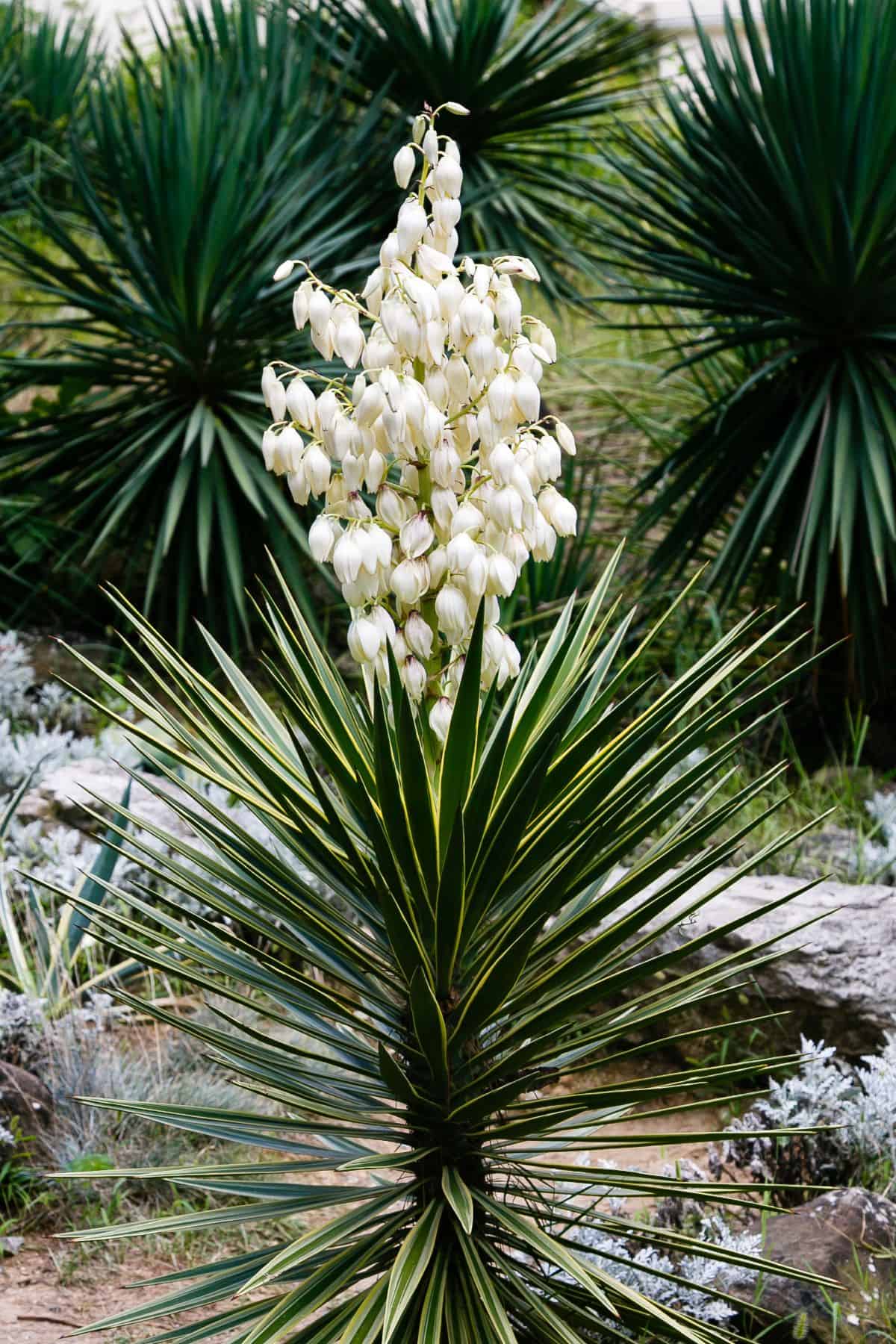
| Maximum Height: | Up to 5 feet |
| Maximum Width: | Up to 5 feet |
| Watering Needs: | Periodically: can be watered once a month unless showing signs of stress |
| Soil Needs: | Loamy, well-fertilized, and well-drained soil |
| Light Needs: | Full Sun |
| Hardiness Zone(s): | Zone 8 and up |
| Bloom Color: | Creamy green-white |
| Bloom Stalk Height: | 20 inches |
| Leaf Type: | Thin and primarily yellow-green; stiff rather than floppy |
| Growth Type: | Shrub yucca |
Known commonly as Buckley’s Yucca, this shrub species is found mostly in Texas and Mexico. Like many yuccas, it can be used as a protective hedge thanks to the spiny leaves. With the additional rigidity that these leaves have, they can also be soaked add used as a source of fiber for weaving.
15. Yucca rupicola
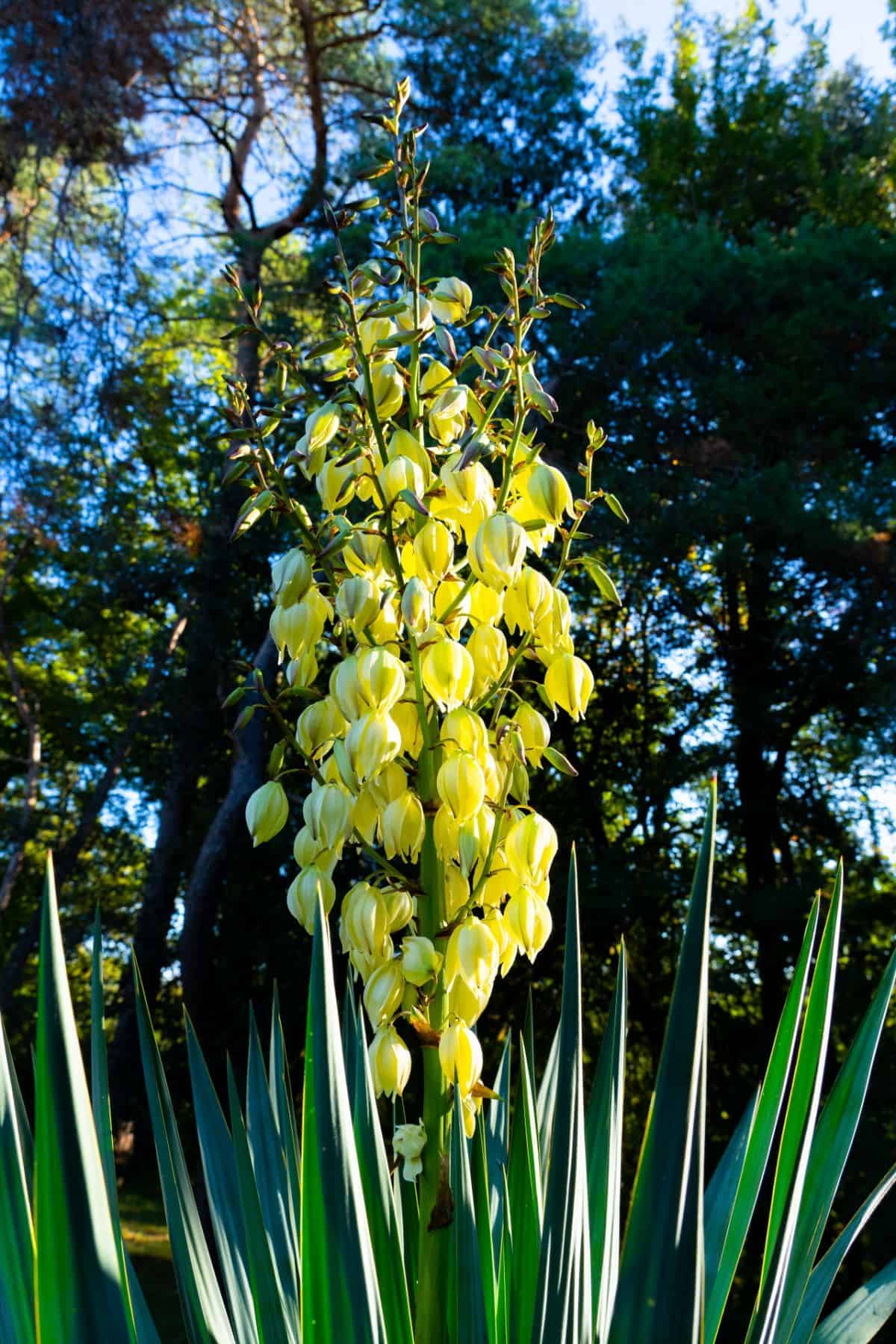
| Maximum Height: | Up to 2 feet |
| Maximum Width: | Up to 5 feet |
| Watering Needs: | Periodically: can be watered once a month unless showing signs of stress |
| Soil Needs: | Loamy, well-fertilized, and well-drained soil |
| Light Needs: | Full Sun |
| Hardiness Zone(s): | Zone 6 and up |
| Bloom Color: | Cream colored |
| Bloom Stalk Height: | 5 feet |
| Leaf Type: | Flexible, and some leaves rotate on themselves |
| Growth Type: | Clumping yucca |
This yucca’s claim to fame isn’t in height or fruit but in the shape of the leaves. The most interesting thing is that not every leaf on this plant twists! Randomly, the leaves will twist on themselves, which is what gives this species the common name of Twisted Leaf Yucca.
16. Yucca whipplei
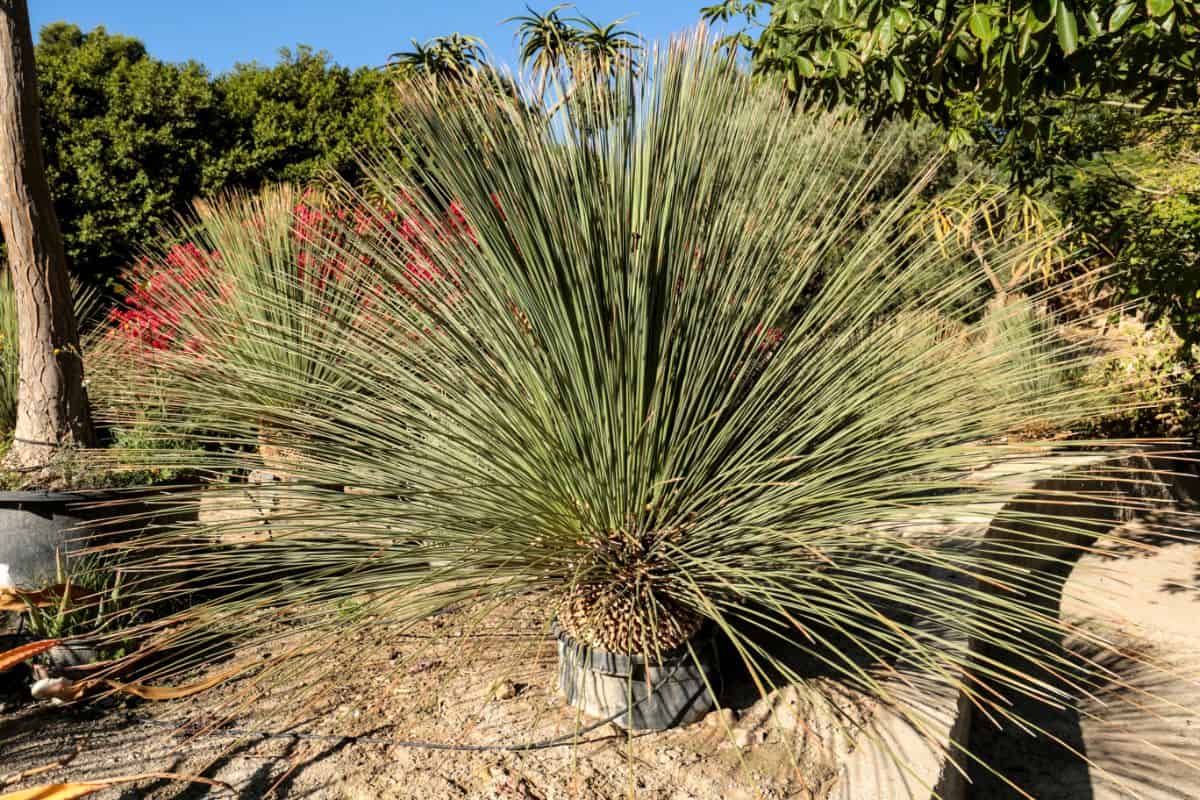
| Maximum Height: | Up to 3 feet |
| Maximum Width: | Up to 4 feet |
| Watering Needs: | Periodically: can be watered once a month unless showing signs of stress |
| Soil Needs: | Loamy, well-fertilized, and well-drained soil |
| Light Needs: | Full Sun |
| Hardiness Zone(s): | Zone 6 and up |
| Bloom Color: | Creamy white with some purple along the edges |
| Bloom Stalk Height: | Grows from the center of the plant, not a large stalk |
| Leaf Type: | Thin lanceolate leaves with blue-green coloration and yellow or brown margins. |
| Growth Type: | This is currently argued, however, we will consider this a shrub-like species |
Also known as Our Lord’s Candle, this species has a massive amount of contention around its origins and what exactly it is. Because of its growth patterns, some speculate that this species could instead be a part of the genus hesperoyucca. To date, that is still in debate.
Despite the disagreements, the species is still coveted for its colorful leaves that are spined, but not so much as to cause danger to the gardener or yucca lover … as long as you are careful!
17. Yucca elata
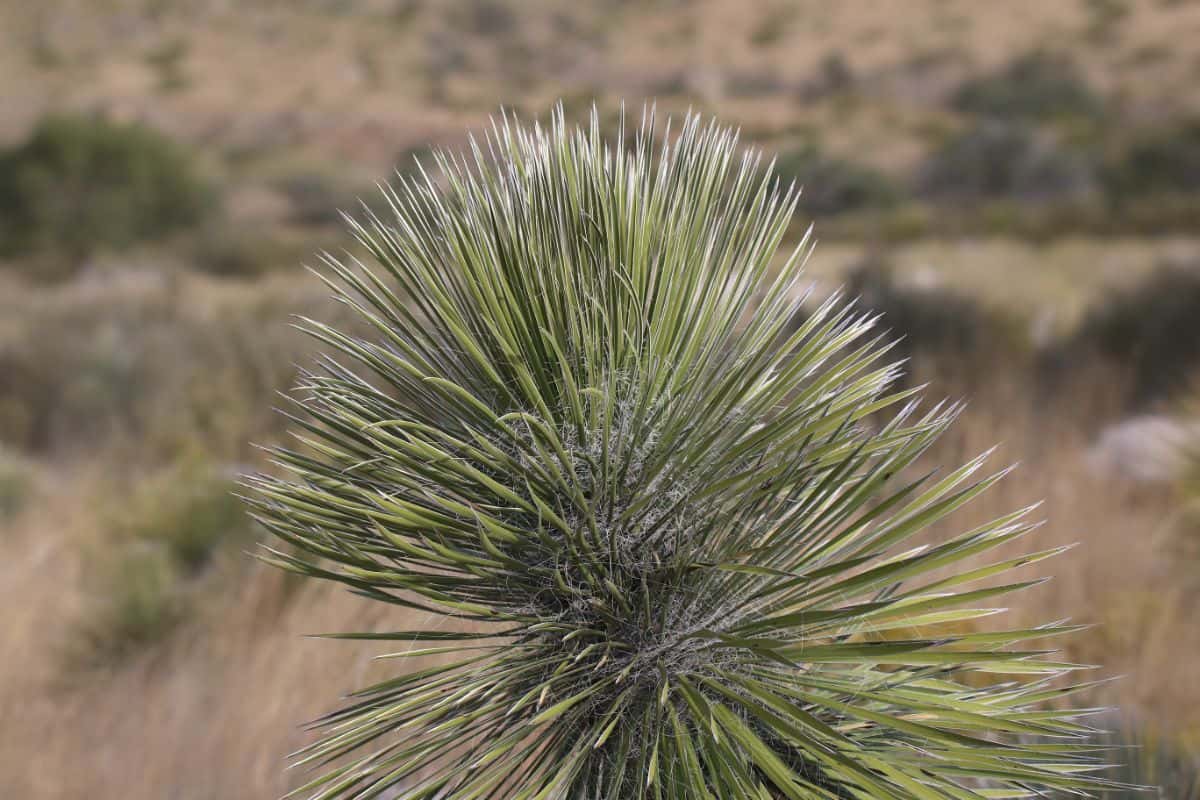
Buy it from:
| Maximum Height: | Up to 20 feet |
| Maximum Width: | Up to 10 feet |
| Watering Needs: | Periodically: can be watered once a month unless showing signs of stress |
| Soil Needs: | Loamy, well-fertilized, and well-drained soil |
| Light Needs: | Full Sun |
| Hardiness Zone(s): | Zone 6 and up |
| Bloom Color: | Creamy white |
| Bloom Stalk Height: | Up to 6 feet |
| Leaf Type: | Up to four feet long and relatively narrow; white margins |
| Growth Type: | Usually, a single-trunk tree yucca |
The Soaptree or Palmilla is a palm tree-looking species of yucca hence the name Palmilla which roughly translates to small palm in Spanish. One of the most attractive elements is the gorgeous, finely textured leaves that form terminal rosettes at the end of the branches. As this species matures, it often has seven or more branches that spread out and provide moderate shade.
18. Yucca pallida
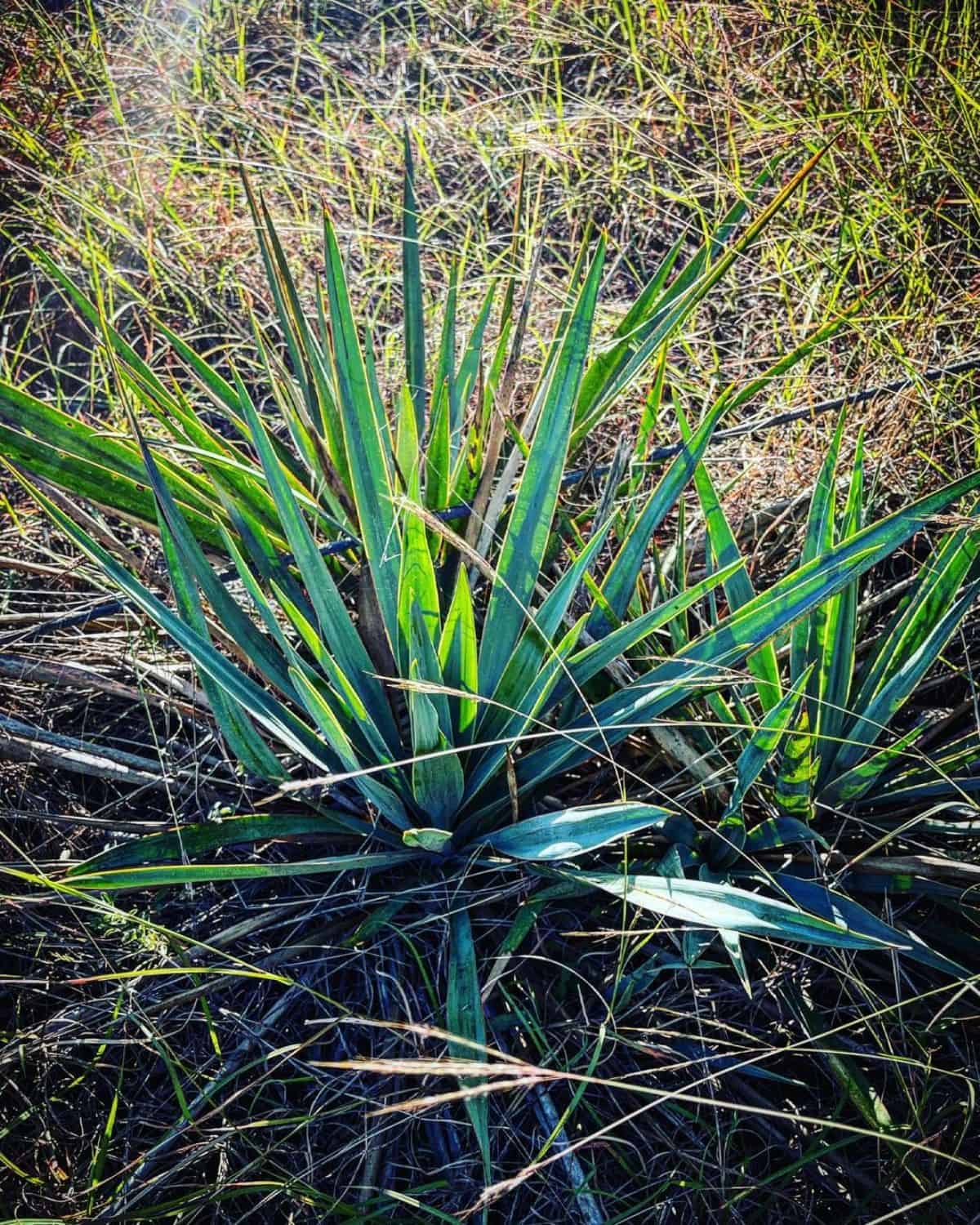
| Maximum Height: | Up to 2 feet |
| Maximum Width: | Up to 3 feet |
| Watering Needs: | Periodically: can be watered once a month unless showing signs of stress |
| Soil Needs: | Loamy, well-fertilized, and well-drained soil |
| Light Needs: | Full Sun |
| Hardiness Zone(s): | Zones 6 - 10 |
| Bloom Color: | Creamy white |
| Bloom Stalk Height: | Up to 6 feet |
| Leaf Type: | More flexible, lance-shaped leaves |
| Growth Type: | Produces rooted offshoots |
Pale-leaf yucca is one of the more interesting stemless species. It can easily be taken care of and kept tidy if you cut back the flowering stems after the blooming season is over. Its more attractive element is that the edges of the leaves are translucent! This makes them seem as though they glow in the evening sun.
19. Yucca faxoniana
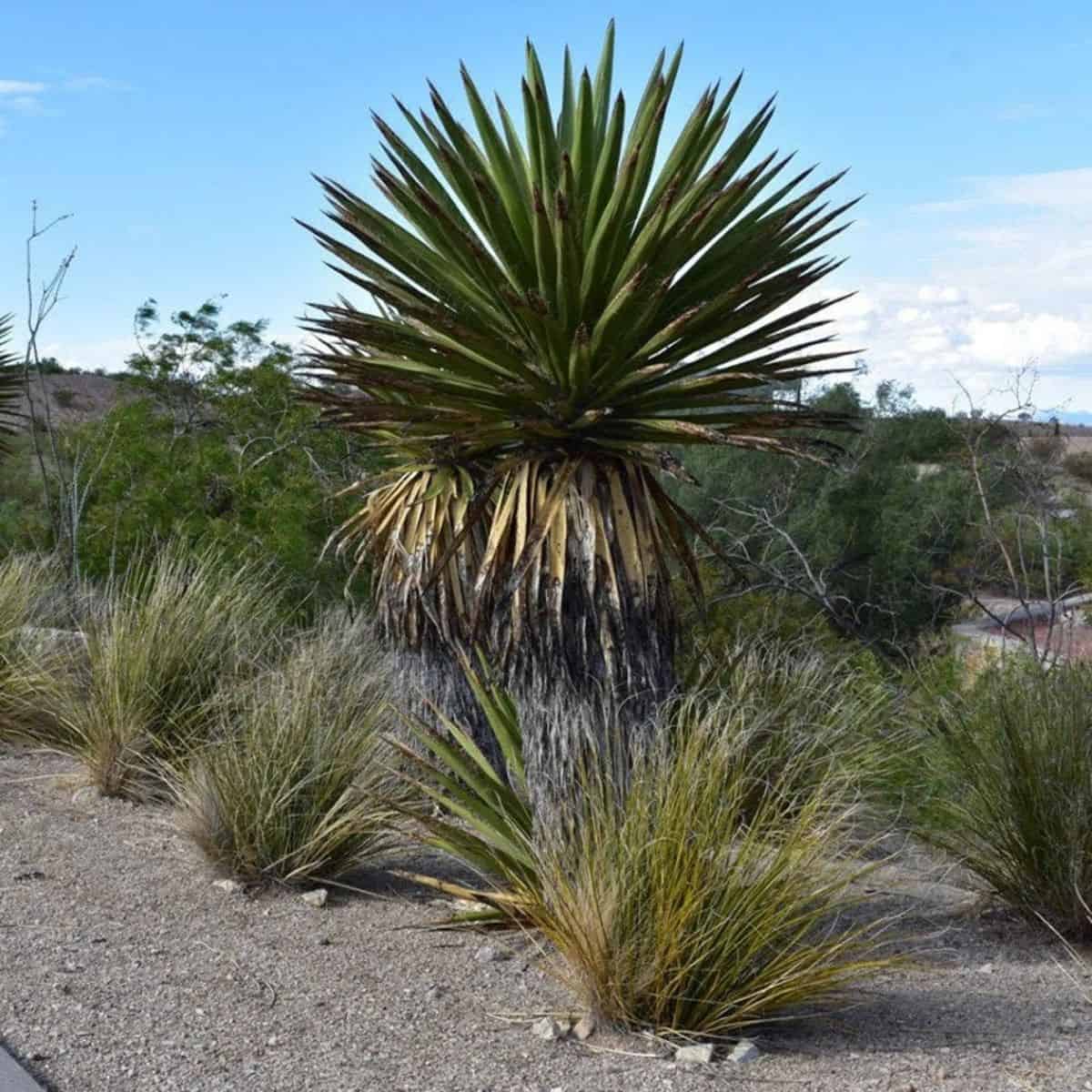
Buy it from:
| Maximum Height: | Up to 12 feet |
| Maximum Width: | Up to 6 feet |
| Watering Needs: | Periodically: can be watered once a month unless showing signs of stress |
| Soil Needs: | Loamy, well-fertilized, and well-drained soil |
| Light Needs: | Full Sun |
| Hardiness Zone(s): | Zones 5 - 10 |
| Bloom Color: | Stark white with some green and cream elements |
| Bloom Stalk Height: | Up to 4 feet |
| Leaf Type: | Very rigid with dangerous terminal spines |
| Growth Type: | Tree yucca |
This yucca goes by a few names: Great White Yucca and Spanish Dagger Tree Yucca. It looks very similar to Spanish Dagger in that the leaves are dagger-shaped and stick out straight in a massive rosette. Its other common name comes from the huge white flowers that rise atop the tree during the blooming season.
20. Mountain yucca
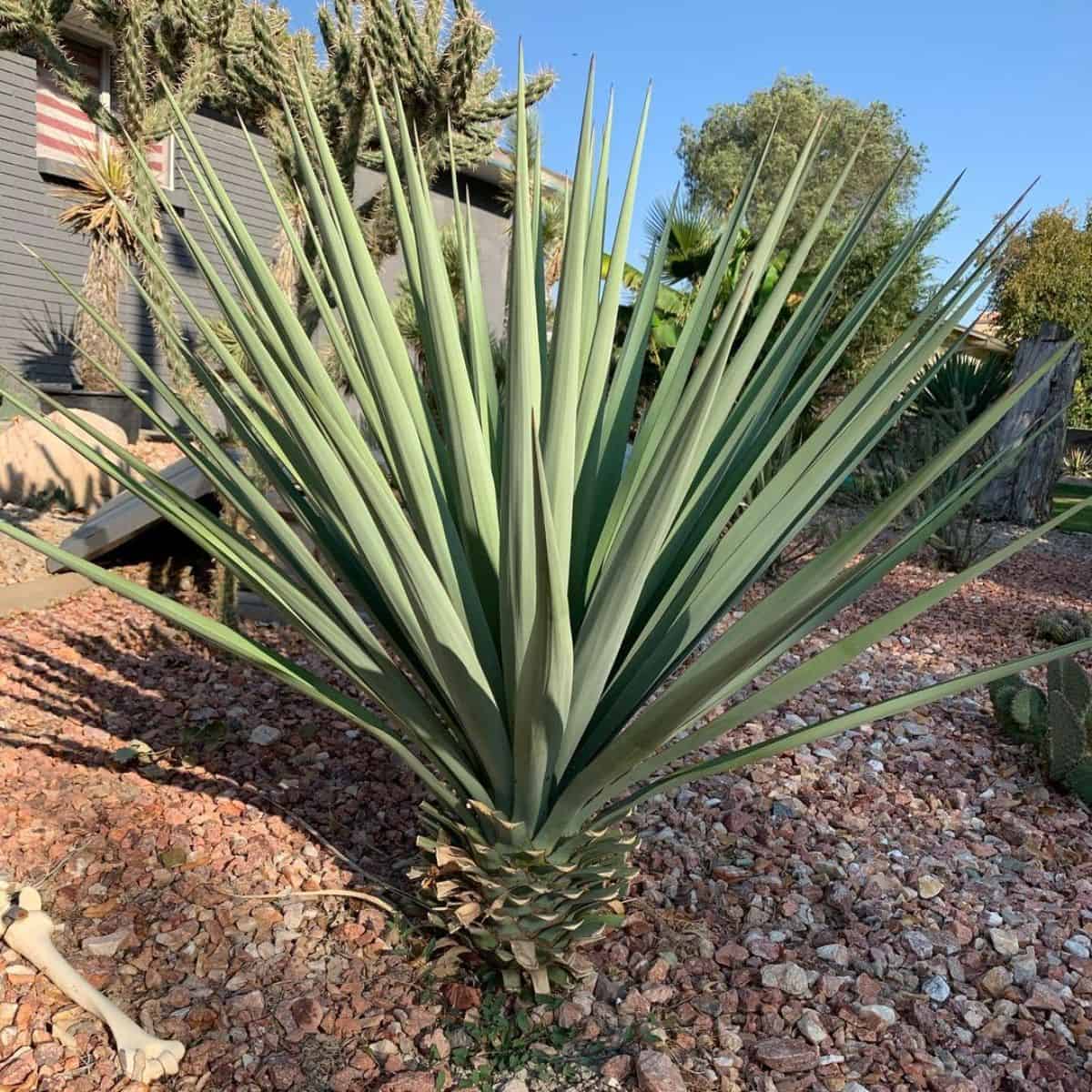
| Maximum Height: | Up to 12 feet |
| Maximum Width: | Up to 6 feet |
| Watering Needs: | Periodically: can be watered once a month unless showing signs of stress |
| Soil Needs: | Loamy, well-fertilized, and well-drained soil |
| Light Needs: | Full Sun |
| Hardiness Zone(s): | Zones 5 - 10 |
| Bloom Color: | Ivory |
| Bloom Stalk Height: | Up to 15 feet |
| Leaf Type: | Stiff singular leaves that can, at times, grow to lengths that make them recurve. |
| Growth Type: | Tree-like |
Yucca schottii, or Schott’s Yucca, is a beautiful steel blue variation of yucca. As the leaves age, it takes a great deal of time for them to fade to a brown skirt that protects the trunk of this yucca tree. It can be grown indoors since it is a slow-growing species; however, it thrives when grown outdoors
21. Yucca thompsoniana
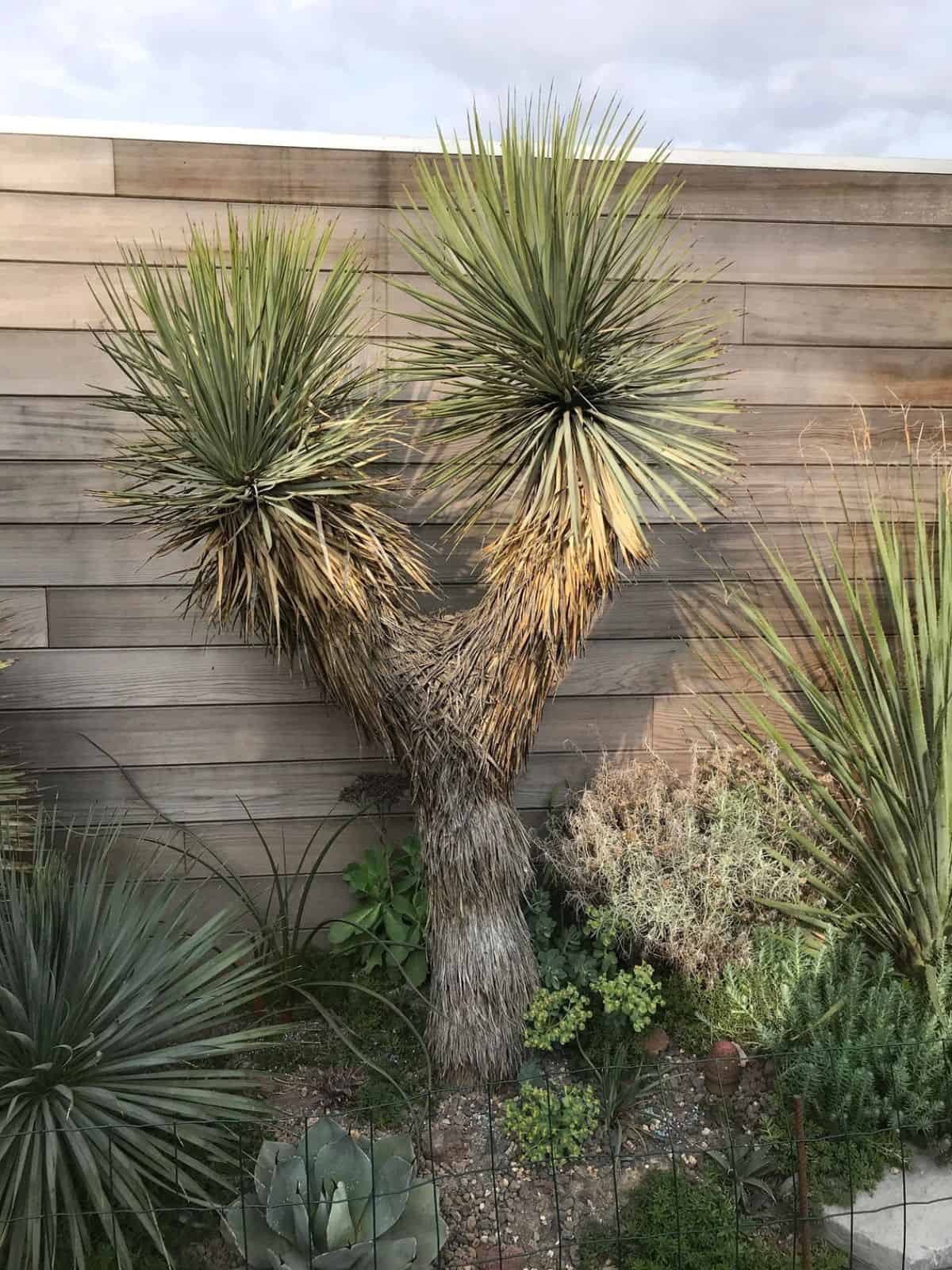
Buy it from:
| Maximum Height: | Up to 10 feet |
| Maximum Width: | Up to 4 feet |
| Watering Needs: | Periodically: can be watered once a month unless showing signs of stress |
| Soil Needs: | Loamy, well-fertilized, and well-drained soil |
| Light Needs: | Full Sun |
| Hardiness Zone(s): | Zone 6 and up |
| Bloom Color: | Cream |
| Bloom Stalk Height: | Up to 3 feet |
| Leaf Type: | Lanceolate and up to two feet in length. Generally dark green. |
| Growth Type: | Tree-like |
One of the more established species, Thompson’s yucca, is a strong, slow-growing species of tree yucca that tends to stay unbranched. If it does branch, the four-foot-wide rosettes provide moderate shade. Old leaves form a grassy skirt that’s not too terribly dangerous since the leaves generally have much smaller teeth and spines.
22. Yucca linearifolia
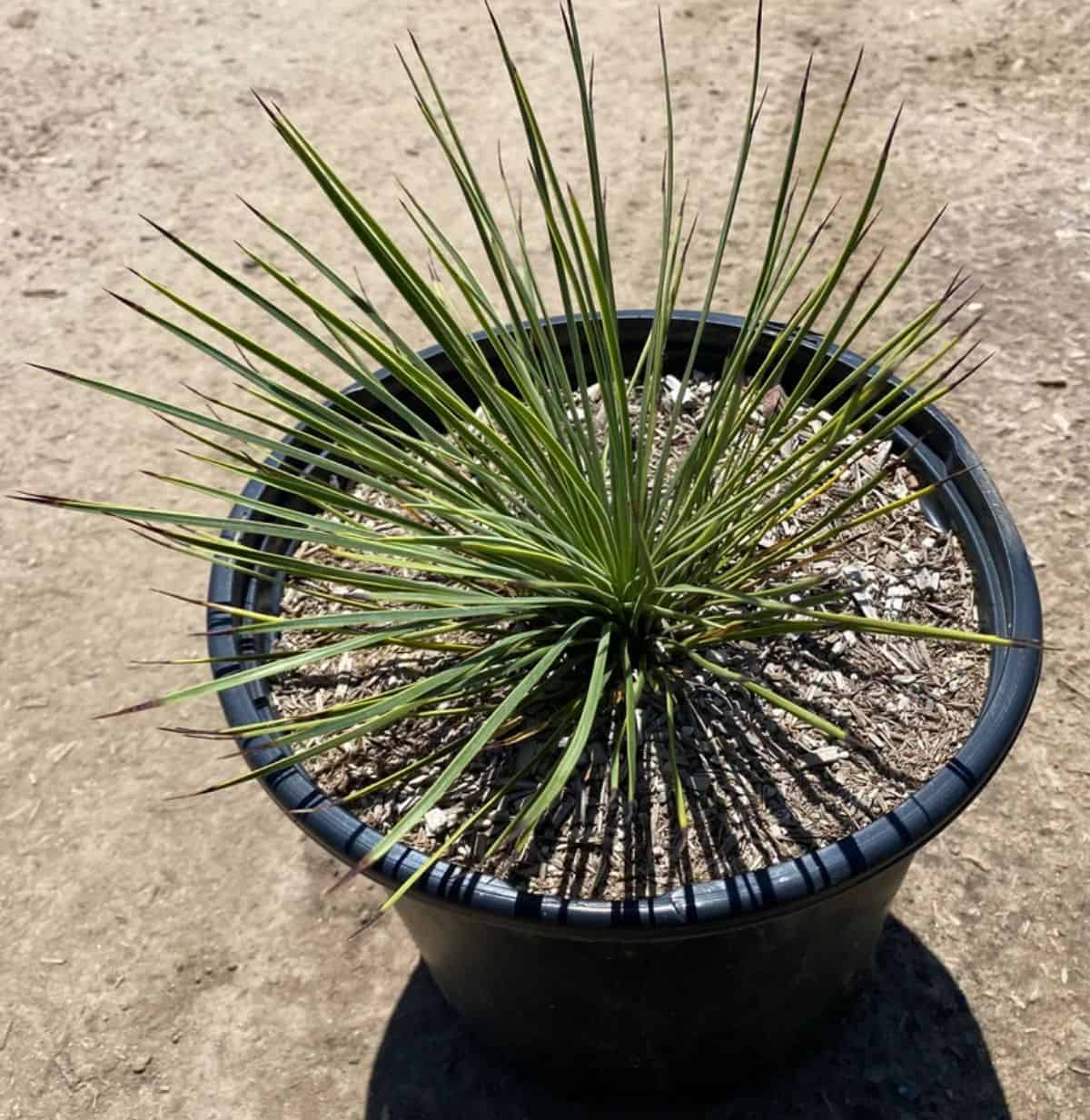
Buy it from:
| Maximum Height: | Up to 4 feet |
| Maximum Width: | Up to 3 feet |
| Watering Needs: | Periodically: can be watered once a month unless showing signs of stress |
| Soil Needs: | Loamy, well-fertilized, and well-drained soil |
| Light Needs: | Full Sun |
| Hardiness Zone(s): | Zone 7 and up |
| Bloom Color: | White |
| Bloom Stalk Height: | Undetermined |
| Leaf Type: | Pliant, gray-green linear leaves |
| Growth Type: | Short tree |
This species is also listed under the name Yucca rostata var. Linaris. This has been a source of debate, but the main difference between Y. rostata and Y. linearifolia is that Y. linearifolia has more elongated fruit than its counterpart.
The foliage grows in an almost perfect globe around the stem, and you don’t have to worry too much about the spines on the leaves.
23. Dasylirion wheeleri
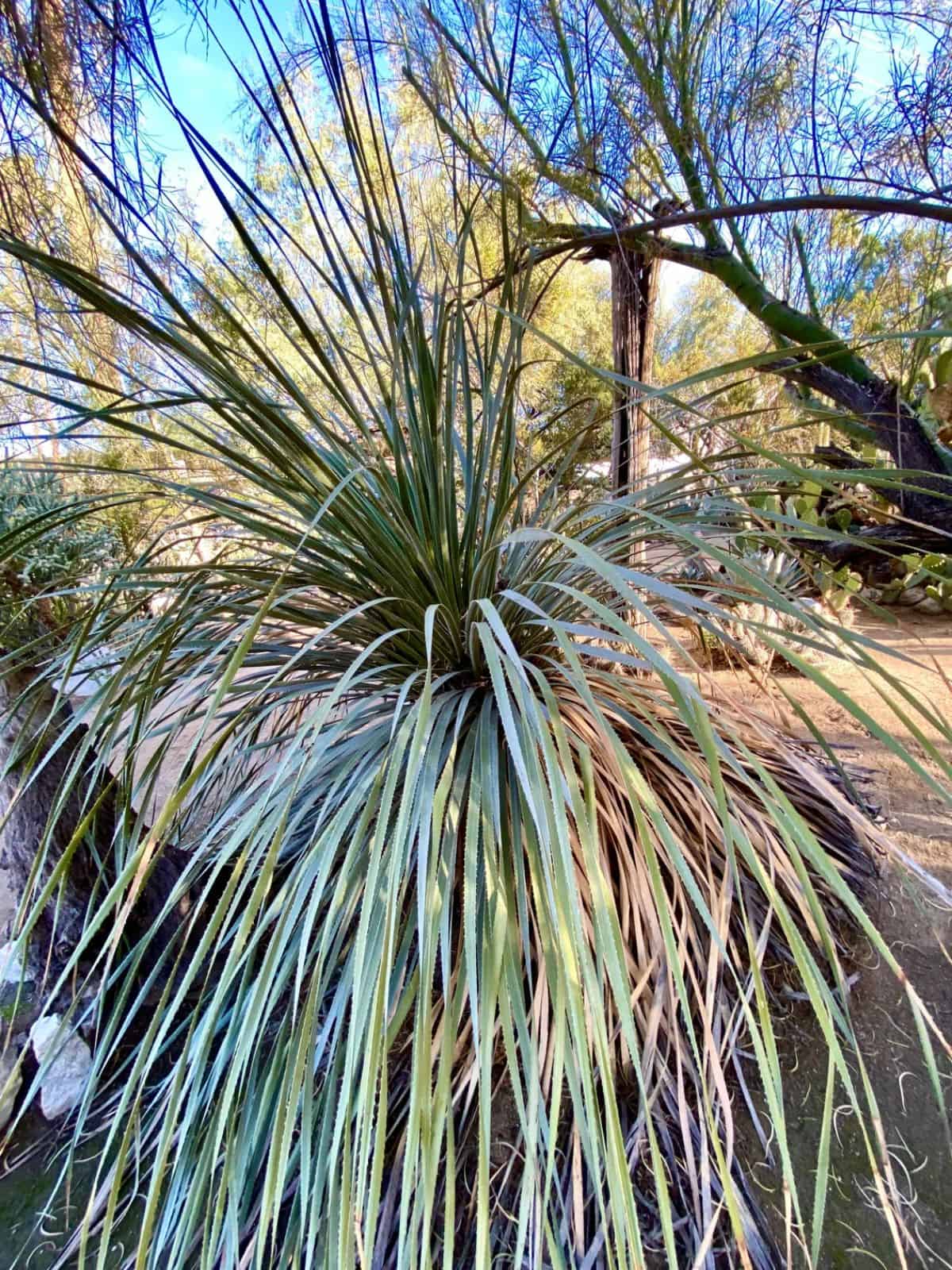
Buy it from:
| Maximum Height: | Up to 6 feet |
| Maximum Width: | Up to 4 feet |
| Watering Needs: | Periodically: can be watered once a month unless showing signs of stress |
| Soil Needs: | Loamy, well-fertilized, and well-drained soil |
| Light Needs: | Full Sun |
| Hardiness Zone(s): | Zone 6 and up |
| Bloom Color: | White |
| Bloom Stalk Height: | Up to 15 feet |
| Leaf Type: | Sharp teeth with lance-like leaves that have a spoon-shaped base. |
| Growth Type: | Short tree/shrub |
At the base of each leaf, you’ll find the shape of a spoon that can easily collect water. One of the most prominent features of this short shrub is its incredibly massive blooming spikes that tower above the rest of the shrub. This is a species that does require careful handling, and leather gloves are suggested if you choose to prune the plant.

